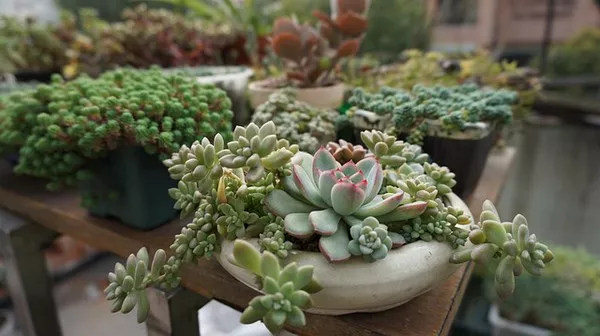Succulents have surged in popularity in recent years, captivating plant enthusiasts with their unique shapes, vibrant colors, and minimal care requirements. Among the myriad of succulent varieties, mixed succulent arrangements stand out as dynamic displays of texture and form. However, caring for mixed succulents can present unique challenges due to the diverse needs of the individual species involved. With the right knowledge and techniques, you can create thriving mixed succulent gardens that are both visually stunning and low-maintenance. In this comprehensive guide, we’ll delve into everything you need to know to care for mixed succulents with confidence and success.
Understanding Mixed Succulents: Diversity in Harmony
Mixed succulent arrangements often feature a variety of species, each with its own growth habits, water requirements, and light preferences. These arrangements may include popular succulents such as Echeveria, Sedum, Crassula, Haworthia, and many more. By combining different types of succulents, you can create visually captivating displays that showcase the beauty of diversity in nature.
Before diving into care tips, it’s crucial to understand the individual needs of the succulents in your arrangement. Research the specific requirements of each species regarding sunlight, water, soil, and temperature. While some succulents thrive in full sun, others prefer partial shade. Similarly, certain species are more drought-tolerant, while others require more frequent watering. By selecting compatible succulents and providing appropriate growing conditions, you can set the stage for success in caring for mixed arrangements.
Essential Care Tips for Mixed Succulents
Light Requirements: Most succulents thrive in bright, indirect light. Place your mixed succulent arrangement near a south- or west-facing window where it can receive ample sunlight throughout the day. However, be cautious of intense midday sun, which can scorch delicate leaves. If your succulents start to stretch or become leggy, it’s a sign they need more light. Consider supplementing natural light with grow lights to ensure optimal conditions, especially during the darker months.
Watering Practices: One of the most common mistakes in succulent care is overwatering. Succulents store water in their leaves and stems, allowing them to survive extended periods of drought. However, they are susceptible to root rot if kept too wet. When watering mixed succulents, allow the soil to dry out completely between waterings. Stick to a thorough but infrequent watering schedule, ensuring that excess water can drain freely from the pot. Always water the soil directly and avoid wetting the leaves to prevent rot and fungal diseases.
Well-Draining Soil: Succulents thrive in well-draining soil that allows excess moisture to escape quickly. Use a specialized succulent or cactus mix, or create your own by mixing potting soil with perlite or coarse sand. This will help prevent water from pooling around the roots, reducing the risk of rot. When repotting or planting mixed succulents, choose containers with drainage holes to further improve soil drainage and aeration.
Temperature and Humidity: Succulents generally prefer warm, dry conditions and can struggle in high humidity environments. Keep your mixed succulent arrangement in a room with moderate temperatures, ideally between 60°F and 80°F (15°C to 27°C). Avoid placing them near drafty windows or heat sources that can cause temperature fluctuations. If you live in a humid climate, ensure adequate air circulation around the plants to prevent fungal issues.
Feeding and Fertilizing: While succulents are relatively low-maintenance plants, they still benefit from occasional feeding during the growing season. Use a balanced, water-soluble fertilizer diluted to half strength, applied every 4-6 weeks. However, avoid fertilizing during the dormant winter months when succulents require less nutrients. Over-fertilizing can lead to salt buildup in the soil, causing damage to the roots.
Troubleshooting Common Issues
Even with proper care, mixed succulents may encounter occasional problems. Here are some common issues and how to address them:
Yellowing or Drooping Leaves: Yellowing or drooping leaves are often a sign of overwatering. Allow the soil to dry out completely before watering again, and adjust your watering frequency as needed. Trim any damaged or rotting leaves to prevent further spread.
Leggy Growth: Leggy growth occurs when succulents stretch towards light sources in search of adequate sunlight. Move your arrangement to a brighter location, or supplement natural light with grow lights to encourage compact, healthy growth.
Pests: Succulents are generally resistant to pests, but they can occasionally attract mealybugs, aphids, or spider mites. Remove any visible pests with a cotton swab dipped in rubbing alcohol, and consider using insecticidal soap for severe infestations.
Root Rot: Root rot is caused by overwatering and can quickly spread throughout the plant if left unchecked. If you suspect root rot, gently remove the affected succulent from the soil, trim away any rotted roots, and allow the plant to dry out before replanting in fresh, well-draining soil.
Conclusion
Caring for mixed succulents offers a rewarding opportunity to explore the diverse world of these resilient plants. By understanding the unique needs of each species and providing appropriate growing conditions, you can create stunning arrangements that thrive with minimal intervention. With proper light, water, soil, and temperature management, your mixed succulents will flourish, bringing joy and beauty to your indoor or outdoor space for years to come.


